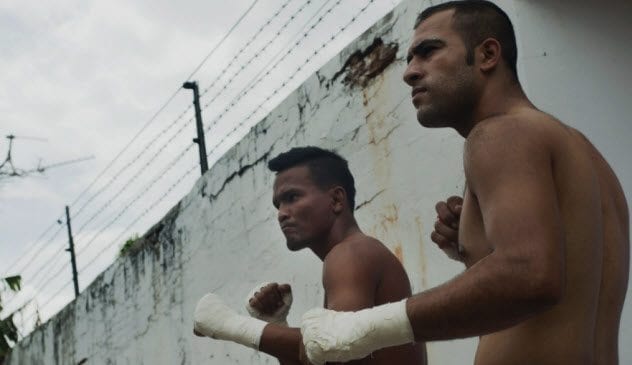 Politics
Politics  Politics
Politics  Weird Stuff
Weird Stuff Ten Bizarre Facts About The Doge Meme
 Our World
Our World 10 Ways Your Christmas Tree Is More Lit Than You Think
 Movies and TV
Movies and TV The 10 Coolest Stars to Set Sail on The Love Boat
 History
History 10 Things You Didn’t Know About the American National Anthem
 Technology
Technology Top 10 Everyday Tech Buzzwords That Hide a Darker Past
 Humans
Humans 10 Everyday Human Behaviors That Are Actually Survival Instincts
 Animals
Animals 10 Animals That Humiliated and Harmed Historical Leaders
 History
History 10 Most Influential Protests in Modern History
 Creepy
Creepy 10 More Representations of Death from Myth, Legend, and Folktale
 Politics
Politics 10 Political Scandals That Sent Crowds Into the Streets
 Weird Stuff
Weird Stuff Ten Bizarre Facts About The Doge Meme
 Our World
Our World 10 Ways Your Christmas Tree Is More Lit Than You Think
Who's Behind Listverse?

Jamie Frater
Head Editor
Jamie founded Listverse due to an insatiable desire to share fascinating, obscure, and bizarre facts. He has been a guest speaker on numerous national radio and television stations and is a five time published author.
More About Us Movies and TV
Movies and TV The 10 Coolest Stars to Set Sail on The Love Boat
 History
History 10 Things You Didn’t Know About the American National Anthem
 Technology
Technology Top 10 Everyday Tech Buzzwords That Hide a Darker Past
 Humans
Humans 10 Everyday Human Behaviors That Are Actually Survival Instincts
 Animals
Animals 10 Animals That Humiliated and Harmed Historical Leaders
 History
History 10 Most Influential Protests in Modern History
 Creepy
Creepy 10 More Representations of Death from Myth, Legend, and Folktale
10 Ways Prisons Torture Inmates In Modern Times
As a public defender, I have seen firsthand the unspeakable abuses that those incarcerated in the United States are forced to endure. This group includes those convicted of crimes and pretrial detainees who are presumed innocent.
Fortunately, you needn’t be on the front lines to bear witness. As the tide turns on prisoners’ rights, respected publications are increasingly devoting time and attention to the horrors of incarceration. Some newspapers have even dedicated entire sections to these issues.
Despite this increased visibility, there is a persistent misconception that incarcerated persons are getting a free ride—or at least more than they deserve. Read the comments section of any prisoners rights’ article, and you will likely find someone claiming that prisoners live better than the middle class.
There is also the misconception that prisoners have no rights, which leads people to conclude that anything prisoners do get is charity. Others have a troubling tendency to turn their backs on pain that they perceive as self-inflicted. The logic goes something like this: These people committed a crime, so they deserve whatever happens to them in prison.
Before you conclude that prisoners simply get what they deserve, read below for some of the shocking ways that prisons torture inmates in modern times. Many of these practices will leave even the most stonehearted begging for reform.
10 Scalding Showers

In 2012, prison authorities boiled Darren Rainey to death when they forced him to take a two-hour shower in scalding water that was 82 degrees Celsius (180 °F). The water, hot enough to cook a cup of overpriced ramen from the prison commissary, burned over 90 percent of Rainey’s body. As staff members pulled Rainey’s limp body from the shower, his skin sloughed off. They had, in essence, cooked him alive.
His offense?
Rainey, who was schizophrenic, had defecated in his cell. When Harriet Krzykowski, a former counselor at the Dade Correctional Institution, asked a guard how they were going to deal with Rainey, the guard calmly assured her, “Oh, don’t worry, we’ll put him in the shower.” Krzykowski assumed this was a good thing.
The next day, Krzykowski learned that the guards had locked Rainey in a claustrophobic stall and showered him, by force, with a hose. Only the guards, not Rainey, were able to control the water temperature. Because the shower was so small, there was nothing Rainey could do to escape the scalding water.
Nearby inmates reported that Rainey had screamed for help during the two-hour torture session. Rainey, who was serving a sentence for cocaine possession, a nonviolent offense, was cooked like a lobster.
According to Rainey’s fellow inmates, Rainey was not the first person who had been locked in the shower under these conditions. However, he was the first to die.
9 Forcing Inmates To Fight

“Mandingo” fighting, a practice in which slaves were forced to fight to the death, has been widely discredited. Yet in modern correctional facilities across the United States, guards force majority–minority inmates to fight one another for entertainment. In San Francisco’s main jail, reserved for pretrial detainees and those serving short sentences, these forced fights have been dubbed “gladiator matches.”
According to San Francisco Public Defender Jeff Adachi, guards place bets on who they think will win. If inmates refuse to fight, officers threaten them with rape and other acts of violence. Adachi stated of the practice, “I can only describe this as an outrageously sadistic scenario that sounds like it’s out of Game of Thrones.”
Former inmate Rico Palikiko Garcia described how these fights, which he participated in under the threat of being beaten and tased, left him with broken ribs. According to Garcia, guards warned the inmates that they would be beaten if they were honest about the source of their injuries.
One guard allegedly instructed an inmate to tell jail medical staff that he had fallen from his bunk. Officers forced another victim, Stanley Harris, to do push-ups in preparation for the fights. Harris claims that prison staff threatened him with anal rape if he did not comply.
8 Withholding Pads And Tampons

Across the United States, dozens of jails and prisons fail to provide female inmates with free pads and tampons. Those that do often have a serious undersupply.
Indigent inmates, who make up the majority of the prison population, are forced to get creative. They fashion sanitary napkins out of toilet paper, socks, prison slippers, and anything else they can get their hands on. Often, these makeshift pads result in illness and infection.
This humiliating practice forces inmates to bleed through their prison scrubs, often while being monitored by male guards. Perhaps that’s why, according to an ACLU lawsuit, some correctional facilities withhold these critical supplies as a way to punish inmates.
This isn’t the only way that female inmates are punished. In my capacity as a public interest attorney, I have witnessed members of this vulnerable population subjected to sexual assault during unsanitary and unsafe gynecological exams.
I have heard stories of inmates shackled while giving birth, too-tight cuffs cutting into their wrists and ankles as intensely painful contractions make them writhe. I have also heard of female inmates being leered at and subjected to racial slurs while being forced to use the toilet in front of male guards.
7 Refusing To Provide Basic Medical Care

It took Tyler Tabor, who was held in the Adams County jail in Pennsylvania in 2015, three full days to die from heroin withdrawal. According to attorney David Lane, who represents Tabor’s family in a civil suit, “[Tabor] told the jail he was suffering from withdrawal, and he begged them for an IV, which would have saved his life.”
Unassisted drug withdrawal can cause grand mal seizures, dehydration, and more. Tabor’s bond was only $300, but his family elected to leave him in jail to detox, which they assumed Tabor could do safely at a government-run facility.
In another Pennsylvania correctional facility, Victoria “Tori” Herr, who had been using approximately 10 bags of heroin a day, was experiencing severe heroin withdrawal. During a jail call three days after her arrest, Herr told her mother, “I’m seeing people die. I’m going to die.”
Despite having informed jail staff members of her habit, Herr did not receive medical intervention until it was too late. She eventually lost consciousness and was transported to a hospital, where she died after being taken off life support.
6 Ignoring Cries For Help

Only a few hours after prison workers forced him into a cell with an inmate known for getting into violent altercations with others, Ricky Martin, incarcerated in Florida’s Santa Rosa Correctional Institution, was dead. In March 2012, guards found Martin beaten to a pulp. His skull was smashed, his body black and blue.
He had apparently been restrained and noosed with ribbons of torn fabric. The prison scrubs he wore were soaked with blood and pulled over his head, perhaps indicating rape. Earlier, Martin had reportedly begged to be moved to a new cell out of fear for his life.
Witnesses to the beating report hearing screams and thuds. Evidence suggests that the perpetrator, inmate Shawn “Jiggaman” Rogers, used a sock stuffed with batteries. Those same witnesses recall that Rogers had jumped on Martin’s head multiple times, smashing it into the concrete floor.
Yet despite Martin’s repeated cries for help, prison staff failed to respond—until it was too late. During the attack, inmates pleaded with officers to assist Martin. Video taken during the incident shows a guard glancing inside the cell during the attack but ultimately refusing to come to Martin’s aid.
5 Dehydration, Starvation, And Solitary Confinement

In 2016, Terrill Thomas died of dehydration while confined in Milwaukee County jail. The medical examiner who conducted Thomas’s autopsy called his dehydration “profound.” At the time of his death, Thomas, who was mentally ill, was in his 10th day of solitary confinement. Corrections officers claim that they turned off Thomas’s water after he flooded his cell.
According to Thomas’s family, this was torture. Witnesses report hearing Thomas begging for water for several days. In an email statement, Sheriff David Clarke refused to comment on the lawsuit.
However, Clarke took care to note Thomas’s alleged criminal background, as if that justified his totally preventable death:
I have nearly 1,000 inmates. I don’t know all their names, but is this the guy who was in custody for shooting up the Potawatomi Casino, causing one man to be hit by gunfire while in possession of a firearm by a career convicted felon? The media never reports that in stories about him. If that is him, then at least I know who you are talking about.
4 Botched Executions

When he was sentenced to die after being convicted of the 1994 murder of a convenience store clerk, Ronald Smith Jr. was promised a quick, painless death. He wasn’t even supposed to die. A jury had voted to recommend life imprisonment without parole. Unfortunately, in Alabama where Smith was convicted, judges can and routinely do override jury recommendations.
Smith’s death was neither quick nor painless. In killing Smith, Alabama used the controversial drug midazolam, which has been implicated in several botched executions. Many argue that the drug cannot reliably induce unconsciousness. Indeed, the FDA has refused to approve the drug for use as a standalone anesthetic.
This was evident during Smith’s execution, which lasted 34 minutes. For 13 of those minutes, Smith struggled for breath. He heaved, coughed, and clenched his fist. Intermittently, he opened his left eye and looked around the room.
Smith continued to do this well after corrections officers performed the first consciousness test, during which the officers called out Smith’s name and pinched him. Even after the second consciousness test, Smith still moved his right arm.
3 ‘Rectal Feeding’

At Guantanamo Bay, CIA operatives forced at least five detainees to undergo something they call “rectal rehydration and feeding.” The process is as barbaric as it sounds.
Restrained inmates are made to kneel on the floor, naked, while a tube is forced inside them. Ostensibly, the tube delivers nutrients to inmates who engage in hunger strikes. However, the procedure is also recognized as “a means of behavior control.”
One CIA operative noted of Abd al-Rahim al-Nashiri, who was subjected to this cruel practice, “We used the largest [ . . . ] tube we had.” CIA’s chief interrogator ordered rectal feeding of Khalid Sheikh Mohammed, another detainee, “without a determination of medical need.”
In the medical community, this risky procedure has almost universally been replaced with IV support. Complications of rectal feeding include damage to the colon and rectum, infection due to food rotting inside the digestive tract, and prolapsed rectum due to careless insertion (among other risks).
Per the CIA’s own records, at least one Guantanamo detainee, Mustafa al-Hawsawi, was left with an anal fissure, chronic hemorrhoids, and rectal prolapse after being forced to undergo the procedure.
2 Overcrowded And Underprepared

In 2015, when prison officials finally came to Nicholas Rodriguez’s aid, he was long gone. Rodriguez, who had gone missing during a riot 15 hours earlier, was nearly sawed in two. Horrifyingly, most of his organs had been ripped out of his body. What was left of him was folded and stuffed inside a garbage can.
Though inmate homicides are common in California prisons, 24-year-old Rodriguez’s death stands out as particularly gruesome. Though the Vacaville prison was only a medium-security facility, many wonder how such a gruesome killing occurred inside a locked, monitored prison and why it took so long to discover.
Twenty-four hours before Rodriguez’s body was found, there had been an early morning riot in the prison yard. By afternoon, during a daily inmate count, the guards noticed that Rodriguez was missing. They assumed that he had escaped, so they failed to address his disappearance for hours.
At the time of his death, the Vacaville prison, located just outside Sacramento, housed about 3,850 inmates. It was designed to accommodate 2,610.
1 Psychological Abuse

In September 2013, Richard Mair, locked up in Dade Correctional Institute’s Mental Health Unit, hanged himself. In his suicide note, Mair accused prison guards of punishing inmates with starvation. He also repeated the assertions of other inmates—that officers forced them to fight and placed bets on the winners.
Mair also alleged sexual assault by prison employees, claiming that one asked Mair to strip out of his clothes and touch himself in exchange for cigarettes. Mair had been raped in the past. In his suicide note, he claimed that the officer knew it.
In fact, Mair suggested that he was in the mental health unit to get help for his depression and suicidal tendencies, all of which were worsened by the recent sexual assault. Mair wrote that when he refused the lieutenant’s advances, the lieutenant “slammed [him] against the wall, kicked [him] in the groin . . . and told [him] to keep [his] mouth shut or else.”
Given that Florida spends less money per capita on mental health than any state except Idaho, Mair’s death is unsurprising. But it shouldn’t be.
Marie Peale is a public defender in the Washington Metro area. Her professional interests include indigent defense and prisoners’ rights. When Marie isn’t working, she enjoys photographing food, hanging out with her rescue animals, and reading and watching thrillers.








